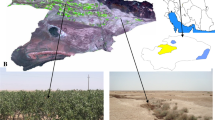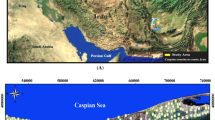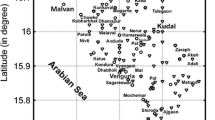Abstract
Groundwater is one of the major sources of exploitation in arid and semiarid regions. Spatial and temporal quality distribution is an important factor in groundwater management. Thus for protecting groundwater quality, data on spatial and temporal distribution are important. Geostatistical models are the most advanced techniques for interpolation and spatial prediction of groundwater parameters. Determining the best and the most suitable model is also very essential which is the main aim in this study. In this research, inverse distance weighted (IDW), kriging, and cokriging methods in geostatistical and artificial neural network (ANN) and adaptive network-based fuzzy inference system (ANFIS) models were used for predicting the spatial distribution of groundwater electrical conductivity (EC) and those were compared together. EC and chloride (Cl−) are two important indicators for water quality assessment. Data were related to 120 wells in Mashhad plain (Iran). Groundwater resources have an important role in this region due to surface water deficit. After normalization of data, to geostatistical models, variograme was drawn; for selecting a suitable model for fitness on experimental variograme, less RSS value was used. Then using cross-validation and root mean square error (RMSE), the best method for interpolation was selected. To compare these three models, we used 25 % of observation data and determined the R 2, RMSE, and MAE parameters. Different ANFIS structures were examined. Also in ANFIS method, different types of membership function, such as Gaussian, bell shape, and trapezoid for inputs of model, were used. Results showed that for interpolation of groundwater quality, cokriging method is superior to kriging method in geostatistical model. In cokriging method, Cl parameter was selected as auxiliary variable which had the highest correlation with EC. Results showed that ANN model had the best accuracy (R 2 = 0.932, RMSE = 367.9, MAE = 265.78 μmos/cm) than ANFIS and geostatistical models.






Similar content being viewed by others
References
Ahmed S (2002) Groundwater monitoring network design: application of geostatistics with a few case studies from a granitic aquifer in a semiarid region. In: Herif MM, Singh VP, Al-Rashed M (eds) Groundwater Hydrology, vol 2. Balkema, Tokyo, pp 37–57
Barca E, Passarella G (2007) Spatial evaluation of the risk of groundwater quality degradation. A comparison between disjunctive kriging and geostatistical simulation, Environ Monit Assess 137(1–3):261–273
Clair TA, Ehrman JM (1996) Variations in discharge and dissolved organic carbon and nitrogen export from terrestrial basins with changes in climate: a neural network approach. Limnol Oceanogr 41(5):921–927
Coulibaly P, Anctil F, Bobee B (1999) Provision hydrologique par reseaux de neurons artificials. Can J Civil Eng 26(3):293–304
Coulibaly P, Anctil FO, Aravena R, Bobe B (2001) Artificial neural network modeling of water table depth fluctuation. Water Resour Res 37(4):885–896
Daliakopoulosa IN, Coulibalya P, Tsanisb IK (2005) Groundwater level forecasting using artificial neural networks. J Hydrol 309:229–240
Dagostino V, Greene EA, Passarella G, Vurro M (1998) Spatial and temporal study of nitrate concentration in groundwater by means of co regionalization. Environ Geol 36:285–295
Doğan E (2008) Reference evapotranspiration estimation using adaptive neuro-fuzzy inference system. J Irrig Drain Eng ASCE 58:617–628
Finke PA, Brus DJ, Finke PA, Brus DJ, Bierkens MFP, Hoogland T, Knotters M, De Vries F (2004) Mapping groundwater dynamics using multiple sources of exhaustive high resolution data. Geoderma 123:23–39
Gaus I, Kinniburgh DG, Talbot JC, Webster R (2003) Geostatistical analysis of rsenic concentration in groundwater in Bangladesh using disjunctive kriging. Environ Geol 44:939–948
Gundogdu KS, Guney I (2007) Spatial analyses of groundwater levels using universal kriging. J Earth Syst Sci 116(1):49–55
Iphar M (2012) ANN and ANFIS performance prediction models for hydraulic impact hammers. Tunn Undergr Space Technol 27(1):23–29
Istok JD, Cooper RM (1998) Geostatistics applied to groundwater pollution. III: global estimates. J Environ Eng 114(4):915–928
Kabiri-Samania AR, Aghaee-Tarazjanib J, Borgheic SM, Jengd DS (2011) Application of neural networks and fuzzy logic models to long-shore sediment Transport. Appl Soft Comput 11:2880–2887
Farahmand A, Manshouri M, Liaghat A, Sedghi H (2010) Comparison of kriging, ANN and ANFIS models for spatial and temporal distribution modeling of groundwater contaminants. J Food Agric Environ (JFAE) 8(3–4):1146–1155
Karaca F, Ozkaya B (2006) A neural network-based model for controlling leachate flow-rate in a municipal solid waste landfill site. Environ Model Softw 21(8):1190–1197
Kiani S, Jafari A (2012) Crop detection and positioning in the field using discriminate analysis and neural networks based on shape features. J Agr Sci Tech 14:755–765
Kisi O, Oztork (2007) Adaptive neurofuzzy computing technique for evapotranspiration estimation. J Irrig Drain Eng ASCE 133(4):368–379
Khashei-Siuki A, Kouchakzadeh M, Ghahraman B (2011) Predicting dryland wheat yield from meteorological data using expert system in Khorasan province, I.R. Iran. JAST 13:627–640
Kholghi M, Hosseini SM (2009) Comparison of groundwater level estimation using neuro-fuzzy and ordinary kriging. Environ Model Assess 14:729–737
Kumara MS, Bhat A (2007) Application of arc GIS geostatistical analyst for interpolating environmental data from observations. Environ Prog 26(3):220–355
Lee ES (2000) Neuro-fuzzy estimation in spatial statistics. J Math Anal Appl 249:221–231. doi:10.1006/jmaa.2000.6938
Lek S, Guiresse M, Giraudel JL (1999) Predicting stream nitrogen concentration from watershed features using neural networks. Water Res 33(16):3469–3478
Mercader S, Cabrera-Mercader CR, Staelin DH (1995) Passive microwave relative humidity retrievals using feed forward neural network. IEEE Trans Geosci Remote Sens 33(6):842–852
Maier HR, Dandy GC (1996) The use of artificial neural networks for the prediction of water quality parameters. Water Resour Res 32(4):1013–1022
Marsily GD, Ahmed S (1987) Application of kriging techniques in groundwater hydrology. J Geol Soc India 29(1):57–79
Najafi MR, Lee KT, Hosseini SM (2007) ANN modeling for estimation of surface and subsurface flows based on watershed geomorphology. J Agric Sci Technol 9:305–316
Nayak PC, Sudheer KP, Rangan DM, Ramasastri KS (2004) Aneuro-fuzzy computing technique for modeling hydrological time series. J Hydrol (Amsterdam) 291:52–66. doi:10.1016/j.jhydrol.2003.12.010
Nayak PC, Rao YRS, Sudheer KP (2006) Groundwater level forecasting in a shallow aquifer using artificial neural network approach. Water Resour Manag 20:77–90
Nazari Zade F, Arshadiyan B, Zand Vakily K (2006( Study of spatial variability of groundwater quality of Balarood Plain in Khuzestan province. The first congress of optimized exploitation from water source of Karoon and Zayanderood Plain. Shahre kord University, Persian Version, pp: 1236–1240
Onkal-Engin G, Demir I, Engin SN (2005) Determination of the relationship between sewage odour and BOD by neural networks. Environ Model Softw 20(7):843–850
Raman H, Chandramouli V (1996) Deriving a general operating policy for reservoirs using neural networks. J Water Resour Plan Manag ASCE 122(5):342–347
Rezaei M, Davatgar N, Tajdari K, Abolpour B (2010) Investigation the spatial variability of some important groundwater quality factors in Guilan, Iran. J Water Soil 24(5):932–941, IN FARSI
Rizzo DM, Mouser JM (2000) Evaluation of Geostatistics for Combined hydrochemistry and Microbial Community Fingerprinting at a Waste Disposal Site, pp: 1–11
Robinson TP, Metternicht G (2006) Testing the performance of spatial interpolation techniques for mapping soil properties. Comput Electron Agric 50:97–108
Rodriguez MJ, Serodes JB (1998) Assessing empirical linear and nonlinear modelling of residual chlorine in urban drinking water systems. Environ Model Softw 14(1):93–102
Rogers LL, Dowla FU (1994) Optimization of groundwater remediation using artificial neural networks with parallel solute transport modeling. Water Resour Res 30(2):457–481
Safari M )2002( Determination filtration network of Groundwater using geostatistic method. Sc Thesis. Tarbiyat Modares University Agricultural Faculty, Persian Version
Sahinkaya E, Muhsin N, Ozkaya B (2008) Neural network prediction of nitrate in groundwater of Harran Plain, Turkey M. Irfan Yesilnacar. Environ Geol 56:19–25
Sahinkaya E, O’zkaya B, Kaksonen AH, Puhakka JA (2007) Neural network prediction of thermophilic (65_C) sulfidogenic fluidized-bed reactor performance for the treatment of metal containing wastewater. Biotechnol Bioeng 97(4):780–787
Setnes M, Babuska R, Verbruggen HB (1998) Transparent fuzzy modeling. Intern J Human–Comput Stud 49:159–179. doi:10.1006/ijhc.1998.0197
Talebizadeh M, Moridnejad A (2011) Uncertainty analysis for the forecast of lake level fluctuations using ensembles of ANN and ANFIS models. Expert Syst Appl 38(4):4126–4135
Taghizadeh M, Zareian Jahromi M, Mahmodi SH, Heidari A (2008) Spatial distribution of groundwater quality with geostatistics (case study: Yazd-Ardakan plain). World Appl Sci J 4(1):09–17
Todd DK (1980) Groundwater hydrology. John Wiley and Sons, New York
Tutmez B, Hatipoglu Z, Kaymak U (2006) Modelling electrical conductivity of groundwater using an adaptive neurofuzzy inference system. Comput Geosci 32:421–433. doi:10.1016/j.cageo.2005.07.003
Wen CW, Lee CS (1998) A neural network approach to multiobjective optimization for water quality management in a river basin. Water Resour Res 34(3):427–436
Yazdani MR, Saghafian B, Mahdian MH, Soltani S (2009) Monthly runoff estimation using artificial neural networks. J Agric Sci Technol 11:355–362
Yesilnacar MI, Sahinkaya E, Naz M, Ozkaya B )2007) Neural network prediction of nitrate in groundwater of Harran Plain, Turke. Journal of Environmental Geology, Publisher: Springer Berlin / Heidelberg, ISSN: 0943–0105 (Print) 1432–0495 (Online)
Yilmaz I, Kaynar O (2011) Multiple regression, ANN (RBF, MLP) and ANFIS models for prediction of swell potential of clayey soils. Expert Syst Appl 38(5):5958–5966
Zounemat-Kermani M, Teshnehlab M (2008) Using adaptive neuro-fuzzy inference system for hydrological time series prediction. Appl Soft Comput 8:928–936
Author information
Authors and Affiliations
Corresponding author
Rights and permissions
About this article
Cite this article
Khashei-Siuki, A., Sarbazi, M. Evaluation of ANFIS, ANN, and geostatistical models to spatial distribution of groundwater quality (case study: Mashhad plain in Iran). Arab J Geosci 8, 903–912 (2015). https://doi.org/10.1007/s12517-013-1179-8
Received:
Accepted:
Published:
Issue Date:
DOI: https://doi.org/10.1007/s12517-013-1179-8




